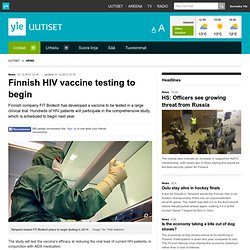

Good bacteria that protects against HIV identified. Researchers at the University of Texas Medical Branch at Galveston by growing vaginal skin cells outside the body and studying the way they interact with "good and bad" bacteria, think they may be able to better identify the good bacteria that protect women from HIV infection and other sexually transmitted infections.

The health of the human vagina depends on a symbiotic/mutually beneficial relationship with "good" bacteria that live on its surface feeding on products produced by vaginal skin cells. These good bacteria, in turn, create a physical and chemical barrier to bad bacteria and viruses including HIV. Study of antibody evolution charts course toward HIV vaccine. 2-Mar-2014 [ Print | E-mail ] Share [ Close Window ] Contact: Laura S.

Leifmanaura.sivitz@nih.gov 301-402-1663NIH/National Institute of Allergy and Infectious Diseases. Finnish HIV vaccine testing to begin. The study will test the vaccine's efficacy at reducing the viral load of current HIV patients, in conjunction with AIDS medication.

The Tampere-based biotechnology company plans to begin testing some time after spring 2014. Previous tests have shown that the vaccine may have the ability to stop the progression of the disease, or at best to eliminate the HIV virus completely. Important collaboration The company is working in collaboration with two leading European Universities, in addition to one or two large American pharmaceutical companies, according to medical doctor and FIT Biotech’s CEO, Kalevi Reijonen. “The study will last two to three years. Some 1,000 patients throughout France and Switzerland will take part on the trials, with the first phase involving hundreds of HIV sufferers.
Crowdfunded AIDS Vaccine. What happens when you combine Microsoft e-Science machine learning, Harvard thinking, and a new medical device to tackle HIV-AIDS?

Rift widens over structure of HIV’s molecular anchor. The structure of a protein known informally as the HIV trimer is among the most highly prized goals of structural biology.

To infect a human cell, HIV sports protrusions that hook on to the cell’s surface. If researchers could find a way to block this process, they might have a way to develop a long-awaited vaccine. But the architecture of this molecular harpoon, which is called envelope glycoprotein and known informally as the HIV trimer, has been the centre of controversy since the summer, when scientists questioned the most precise description of it ever published.
Now three studies have been published, two of them today, all of which agree with one another and differ from that earlier analysis, leading to calls for the paper to be retracted. “I give no weight to the previous paper,” says structural biologist Marin van Heel of Leiden University in the Netherlands. Small wonder New data. How a Supercomputer May Have Finally Unlocked a Way to Beat HIV. Researcher: Substance In Marijuana Could Keep HIV From Entering Brain. FDA approves Truvada, first pill to prevent HIV infections - Metro. Nanoparticles loaded with bee venom kill HIV. Nanoparticles carrying a toxin found in bee venom can destroy human immunodeficiency virus (HIV) while leaving surrounding cells unharmed, researchers at Washington University School of Medicine in St.

Louis have shown. The finding is an important step toward developing a vaginal gel that may prevent the spread of HIV, the virus that causes AIDS. “Our hope is that in places where HIV is running rampant, people could use this gel as a preventive measure to stop the initial infection,” says Joshua L. Hood, MD, PhD, a research instructor in medicine. The study appears in the current issue of Antiviral Therapy. Bee venom contains a potent toxin called melittin that can poke holes in the protective envelope that surrounds HIV, and other viruses. The new study shows that melittin loaded onto these nanoparticles does not harm normal cells. US doctors cure child born with HIV. Link to video: HIV baby cured by US doctors Doctors in the US have made medical history by effectively curing a child born with HIV, the first time such a case has been documented.

The infant, who is now two and a half, needs no medication for HIV, has a normal life expectancy and is highly unlikely to be infectious to others, doctors believe. Beth Israel Deaconess Medical Center, Harvard Medical School Study Confirms Cannabis Science's Approach to Development of CS-TATI-1 to Inhibit Kaposi Sarcoma. Immune cells engineered in lab to resist HIV infection, Stanford study shows. STANFORD, Calif. — Researchers at the Stanford University School of Medicine have found a novel way to engineer key cells of the immune system so they remain resistant to infection with HIV, the virus that causes AIDS.

A new study describes the use of a kind of molecular scissors to cut and paste a series of HIV-resistant genes into T cells, specialized immune cells targeted by the AIDS virus. The genome editing was made in a gene that the virus uses to gain entry into the cell. By inactivating a receptor gene and inserting additional anti-HIV genes, the virus was blocked from entering the cells, thus preventing it from destroying the immune system, said Matthew Porteus, MD, an associate professor of pediatrics at Stanford and a pediatric hematologist/oncologist at Lucile Packard Children's Hospital. The study will be published in the Jan. 22 issue of Molecular Therapy. The Stanford scientists used a similar approach but with an added twist. AIDS CURE U.S. Patent #5676977-THIS VIDEO IS BEING CENSORED!!! 5676977 AIDS.